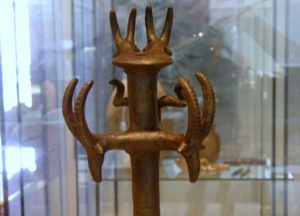
BGU Discovery of Earliest Writings in the World
BGU Discovery of Earliest Writings in the World
August 6, 2019
Ancient Origins – Dr. Nissim Amzallag, a researcher in the Department of Bible, Archaeology and Ancient Near Eastern Studies at Ben-Gurion University, has claimed to have found the earliest writing in the world.
According to Amzallag, a proto-writing system was developed by ancient metalworkers over 6,000 years ago in the southern Levant, a geographical region that more or less corresponds to modern-day Israel, Palestine and Jordan.
Amzallag, an expert on the culture and origins of metalworking in the ancient world, developed the theory after examining the famous hoard from Nahal Mishmar, one of the most important archaeological discoveries from the Chalcolithic era, also known as the Copper Age.
The Nahal Mishmar hoard was found in a cave in 1961 and is 6,300 years old.
The cache included hundreds of mace heads, scepters and strange objects that are crown-shaped. It is believed that these objects were made by members of the mysterious Ghassulian culture and were secreted in the cave by priests from a nearby shrine, possibly during a time of danger, and never recovered.
Amzallag studied the figures, including horned animals, geometric patterns and motifs, and concluded that they were symbolic. He claims to have deciphered their symbols. These signifiers represented physical objects and are known as “logograms” and were the basis of later writing systems.
In order to communicate complex ideas, Amazallag believes the so-called “rebus-principle” was used by the Ghassulians. This principle used “a character, or phonogram, whose corresponding word sounds very similar to the complex idea that the writer is trying to communicate.”
Amazallag purports that the symbols, all signifying some aspect of working with copper and bronze, were in fact a secret code used by Ghassulian smiths.
This aligns with history as the smith’s craft was one that was traditionally considered almost magical and their skills would have been closely guarded. They probably developed the script so that they could share their secrets and instruct other smiths, without divulging them to the general population and to other groups.
While there is academic pushback on this theory, it is generally agreed that the first systematic writing systems were developed in Egypt and Mesopotamia around 3,200 B.C.E. However, Amzallag believes that the Ghassulians helped to develop the “rebus principle,” thus providing a critical contribution to writing and its development.





